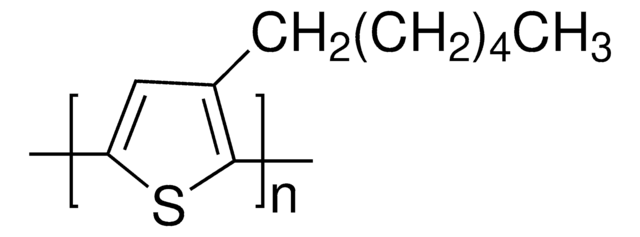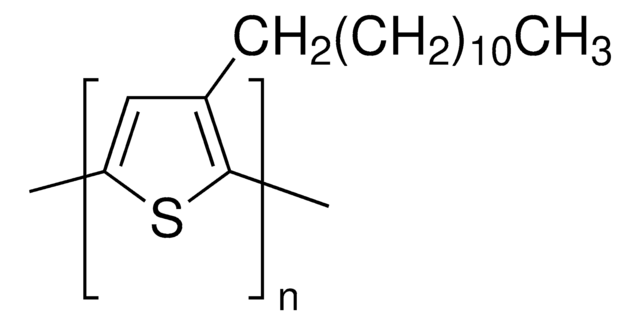Wichtige Dokumente
682799
P3OT
regioregular, electronic grade, 99.995% trace metals basis, average Mn ~25,000
Synonym(e):
Poly(3-octylthiophene-2,5-diyl)
Größe auswählen
About This Item
Empfohlene Produkte
Materialien
black
Qualität
electronic grade
Beschreibung
Band gap: 1.7 eV
Assay
99.995% trace metals basis
Form
solid
Mol-Gew.
average Mn ~25,000
mp (Schmelzpunkt)
198-211 °C
Energie der Orbitale
HOMO -5.25 eV
LUMO -3.55 eV
Leistung von OPV-Bauelementen
ITO/PEDOT:PSS/P3OT:PC61BM (1:2)/LiF/Al
- Short-circuit current density (Jsc): 5.55 mA/cm2
- Open-circuit voltage (Voc): 0.5 V
- Fill Factor (FF): 0.33
- Power Conversion Efficiency (PCE): 0.91 %
Halbleitereigenschaften
P-type (mobility=10−4 - 10−1 cm2/V·s)
SMILES String
[s]1cc(cc1)CCCCCCCC
InChI
1S/C12H20S/c1-2-3-4-5-6-7-8-12-9-10-13-11-12/h9-11H,2-8H2,1H3
InChIKey
WQYWXQCOYRZFAV-UHFFFAOYSA-N
Verwandte Kategorien
Allgemeine Beschreibung
Anwendung
Rechargeable battery electrodes, electrochromic devices, chemical and optical sensors, light-emitting diodes, microelectrical amplifiers, field-effect transistors and non-linear optical materials.
Used in organic field-effect transistors and in polymer-based solar cells.
Leistungsmerkmale und Vorteile
Lagerklassenschlüssel
11 - Combustible Solids
WGK
WGK 3
Flammpunkt (°F)
Not applicable
Flammpunkt (°C)
Not applicable
Persönliche Schutzausrüstung
Eyeshields, Gloves, type N95 (US)
Hier finden Sie alle aktuellen Versionen:
Analysenzertifikate (COA)
Die passende Version wird nicht angezeigt?
Wenn Sie eine bestimmte Version benötigen, können Sie anhand der Lot- oder Chargennummer nach einem spezifischen Zertifikat suchen.
Besitzen Sie dieses Produkt bereits?
In der Dokumentenbibliothek finden Sie die Dokumentation zu den Produkten, die Sie kürzlich erworben haben.
Kunden haben sich ebenfalls angesehen
Artikel
The application of conducting polymers at the interface with biology is an exciting new trend in organic electronics research.
Organic materials in optoelectronic devices like LEDs and solar cells are of significant academic and commercial interest.
Intrinsically stretchable active layers for organic field-effect transistors (OFET) are discussed. Polymer structural modification & post-polymerization modifications are 2 methods to achieve this.
Novel Graphene‑Based Nanostructures Production, Functionalization, and Engineering
Active Filters
Unser Team von Wissenschaftlern verfügt über Erfahrung in allen Forschungsbereichen einschließlich Life Science, Materialwissenschaften, chemischer Synthese, Chromatographie, Analytik und vielen mehr..
Setzen Sie sich mit dem technischen Dienst in Verbindung.

![Poly-[bis-(4-phenyl)-(2,4,6-trimethylphenyl)-amin] a poly(triaryl amine) semiconductor](/deepweb/assets/sigmaaldrich/product/structures/122/933/c34a34ab-284f-4890-adb8-126247a91d9b/640/c34a34ab-284f-4890-adb8-126247a91d9b.png)







